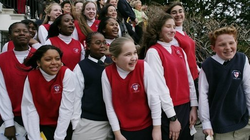Charles Blow, the “Visual Op-Ed Columnist” for the New York Times, devotes his Saturday column this week to the “private school civility gap” – a phenomenon he deems a “not-so-little, not-so-secret, dirty little secret among the upper crust.”
He finds evidence to support his suspicions in a new survey of American students conducted by the Josephson Institute Center for Youth Ethics. Blow trumpets that fact that, among the 43,000 high school students completing the survey, males who attend religious private schools were most likely to report that they had in the past year bullied someone (60%, vs. 55% of males in public schools), used a racial slur or insult (54% vs. 51%), or mistreated someone because he or she belonged to a different group (27% vs. 26%). (I had to look up the exact numbers myself. Oddly for a column devoted to the visual display of quantitative evidence, Blow’s graphic simply includes check marks identifying the group most likely to have offered each troubling response.) “While some public schools have issues with academic attainment,” he concludes, “it appears that some private schools have issues with tolerance.”
Where to begin? Perhaps with the fact that the Josephson Institute survey is not based on a nationally representative sample of American students. In fact, the Institute’s website provides no information whatsoever about the methods used to gather its data. Yes, 43,000 students sounds like a lot! But the most important principle of survey research is that it is not the size of the sample that matters, but rather the degree to which that sample is representative of the population under study. Absent a random sampling process, a larger sample may simply mean more misleading data. On this score, the fact that the share of private school high school students completing the Josephson Institute’s study (more than 15%, according to these tables) is roughly double the share of American high school students actually enrolled in private high schools provides ample reason to be skeptical.
Not only does Blow rely on data of doubtful reliability, he chooses to highlight only those findings that fit with his narrative. No mention is made of the fact that religious private school students were 4 percentage points less likely to report that they were “prejudiced against certain groups” (19% vs. 23%). Nor of the fact just 8% of religious private school students reported that physical violence was a big problem and 7% that they did not feel safe at their school, as compared with 39% and 27%, respectively, of public school students.
Blow’s column is especially puzzling in light of the fact that serious researchers have devoted considerable attention to the issue of tolerance in private schools. In the Summer 2007 issue of Education Next, Patrick Wolf reviewed the findings of more than 21 studies of the effects of attending a private school on a range of civic outcomes. Of the 13 experimental or quasi-experimental studies of the impact of attending a private school on political tolerance, 5 showed a positive effect and 8 showed no effect either way.
Blow is surely right that “some private schools have issues with tolerance.” But the best available evidence suggests that those issues are, if anything, more widespread in the public sector.



